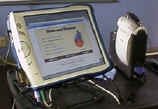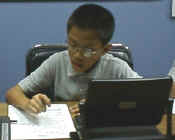Electronic Textbook (Phase II)
Educators, parents, and students have long complained about science
textbooks that are too encyclopedic. The endless new terms, page after
page, fact after fact. Students are bored and learning is compromised.
 Of course you need a curriculum that acts as a baseline to use the
technology. The Integrating Science, Math, and Technology Curriculum
(K-8) is an ideal curriculum to see if technology can enhance learning
for both the teacher and the student. It has been proven in a 10 year
study, that when science is taught in a spiraling manner, science
content comes alive through hands-on materials, reading, art, and
history. The program, which was designed by scientists, continues to be
one of the most rigorous curriculum on the market. However, in the study
we found that administrators and teachers prevented the students from a
fully engaged science program. Most are not trained well enough in our
universities to handle the rigors of teaching science.
Of course you need a curriculum that acts as a baseline to use the
technology. The Integrating Science, Math, and Technology Curriculum
(K-8) is an ideal curriculum to see if technology can enhance learning
for both the teacher and the student. It has been proven in a 10 year
study, that when science is taught in a spiraling manner, science
content comes alive through hands-on materials, reading, art, and
history. The program, which was designed by scientists, continues to be
one of the most rigorous curriculum on the market. However, in the study
we found that administrators and teachers prevented the students from a
fully engaged science program. Most are not trained well enough in our
universities to handle the rigors of teaching science.
Technology can help create an interactive textbook that includes
educational games and quizzes that challenge a studentís ability to
read the material. The technology can also assist the teacher to help
guide their instruction. What teacher doesnít want pictures, video,
and sound that can enhance their presentation.
So we wanted to see if technology could help teachers instruct more
effectively. After several successes and failures with technology, pen
computing, and the internet we feel we are have found a solution.
Curriculum is still the backbone of the project. We are now using pen
computers (QBE, Fujitsu), web appliances (Clio, Knowledge Pad), and LCD
projectors (Compaq).
 With the generous help of Quia Corp., Mainstreet (Clio), Microsoft
(Windows 2000, Windows CE), and Integrated Learning Systems (donated the
projector, pen computers, and Knowledge Pad) we are now embarking on a
new study to determine if students and teachers can use the material and
enhance their learning and presentations.
With the generous help of Quia Corp., Mainstreet (Clio), Microsoft
(Windows 2000, Windows CE), and Integrated Learning Systems (donated the
projector, pen computers, and Knowledge Pad) we are now embarking on a
new study to determine if students and teachers can use the material and
enhance their learning and presentations.
Preliminary results have been very positive. Review
student reaction to the Clio.
 Of course you need a curriculum that acts as a baseline to use the
technology. The Integrating Science, Math, and Technology Curriculum
(K-8) is an ideal curriculum to see if technology can enhance learning
for both the teacher and the student. It has been proven in a 10 year
study, that when science is taught in a spiraling manner, science
content comes alive through hands-on materials, reading, art, and
history. The program, which was designed by scientists, continues to be
one of the most rigorous curriculum on the market. However, in the study
we found that administrators and teachers prevented the students from a
fully engaged science program. Most are not trained well enough in our
universities to handle the rigors of teaching science.
Of course you need a curriculum that acts as a baseline to use the
technology. The Integrating Science, Math, and Technology Curriculum
(K-8) is an ideal curriculum to see if technology can enhance learning
for both the teacher and the student. It has been proven in a 10 year
study, that when science is taught in a spiraling manner, science
content comes alive through hands-on materials, reading, art, and
history. The program, which was designed by scientists, continues to be
one of the most rigorous curriculum on the market. However, in the study
we found that administrators and teachers prevented the students from a
fully engaged science program. Most are not trained well enough in our
universities to handle the rigors of teaching science. With the generous help of Quia Corp., Mainstreet (Clio), Microsoft
(Windows 2000, Windows CE), and Integrated Learning Systems (donated the
projector, pen computers, and Knowledge Pad) we are now embarking on a
new study to determine if students and teachers can use the material and
enhance their learning and presentations.
With the generous help of Quia Corp., Mainstreet (Clio), Microsoft
(Windows 2000, Windows CE), and Integrated Learning Systems (donated the
projector, pen computers, and Knowledge Pad) we are now embarking on a
new study to determine if students and teachers can use the material and
enhance their learning and presentations.